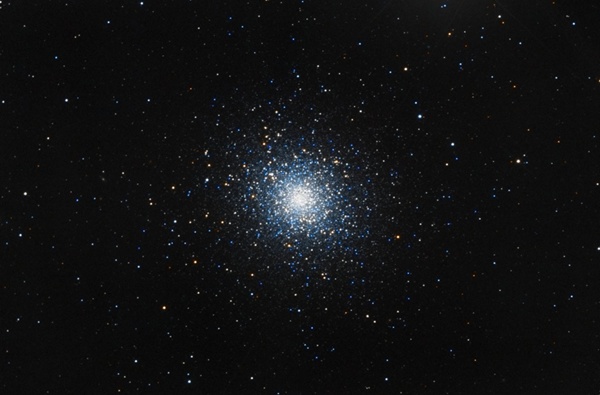The Sky This Week from July 26 to August 4 – Astronomy Magazine
Globular star cluster M5
The bright star cluster M5 in Serpens contains at least 100,000 ancient stars in a densely packed sphere some 165 light-years across. M5 lies roughly 25,000 light-years from Earth.
Ron Brecher
Tonight offers a good opportunity for binocular users to track down the northern sky’s brightest globular cluster. M5, whose 100,000 stars glow at a combined magnitude of 5.7, lies in the southwestern corner of the constellation Serpens the Serpent and stands high in the southwestern sky after darkness falls. You can locate it just 0.4° north-northwest of the 5th-magnitude star 5 Serpentis. Binoculars show the cluster as a hazy ball of light punctuated by a bright core.
Saturday, July 27
The dwarf planet Ceres appears about 25° high in the south-southwest as darkness falls and makes a tempting target during the early evening hours. Glowing at 8th magnitude, it’s easy to find through binoculars or a telescope among the bright stars along the border between Scorpius and Libra. Tonight, Ceres lies 2.8° due west of the lovely 2nd-magnitude double star Beta (β) Scorpii. But even more impressively, it stands just 8′ northeast of the magnitude 5.0 star Lambda (λ) Librae.
Look for the waning crescent Moon this morning as it hovers just west of the Hyades star cluster in Taurus the Bull. The two objects clear the horizon by 3 a.m. local daylight time and appear some 25° high in the east as morning twilight starts to paint the sky. The Moon appears about 25 percent lit and easily outshines the stars of the V-shaped Hyades. First-magnitude Aldebaran, which marks one tip of the V, appears brighter than the rest of the cluster’s stars because it actually lies in the foreground.
Sunday, July 28
Observers of the outer solar system can get a good view of Uranus before dawn. The best time to look for it is shortly before twilight begins around 4 a.m. local daylight time. Uranus then lies 45° high in the east-southeast against the backdrop of southern Aries the Ram. This morning, use binoculars to find the magnitude 5.8 planet 2.3° south-southeast of the magnitude 5.7 star 19 Arietis. A telescope reveals Uranus’ blue-green disk, which spans 3.6″.
Monday, July 29
Although Jupiter reached opposition and peak visibility more than a month ago, it remains a stunning sight from shortly after sunset until well past midnight. It resides among the background stars of southern Ophiuchus the Serpent-bearer, a region that climbs highest in the south around 9:30 p.m. local daylight time. Shining at magnitude –2.4, Jupiter is the night sky’s most conspicuous object until the Moon rises around the start of morning twilight. When viewed through a telescope, the planet’s disk spans 43″ and shows striking cloud-top detail.







